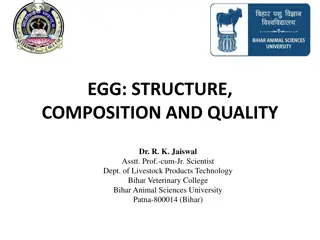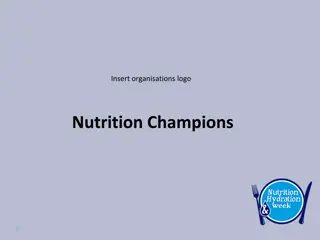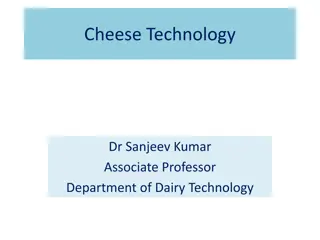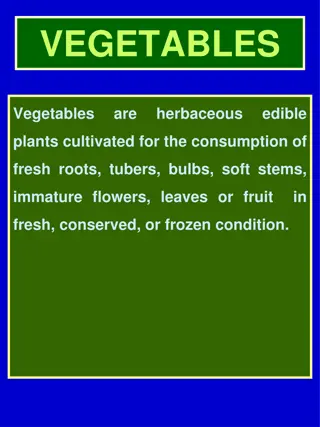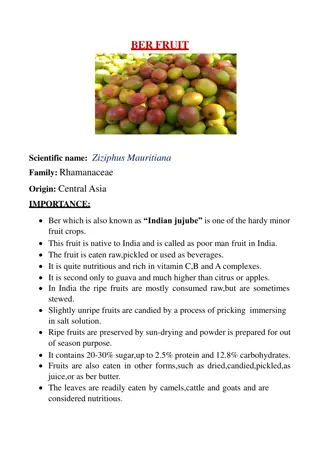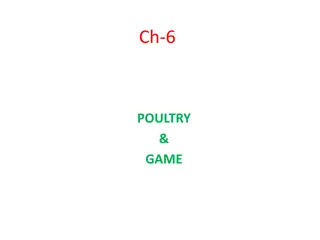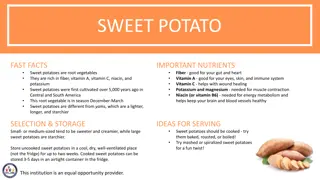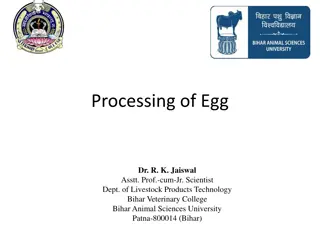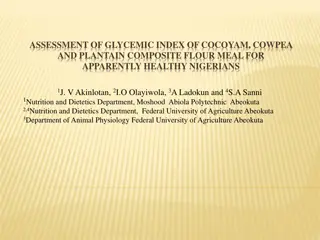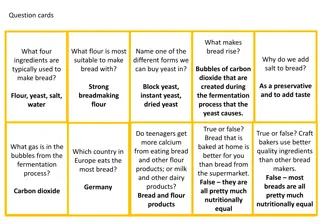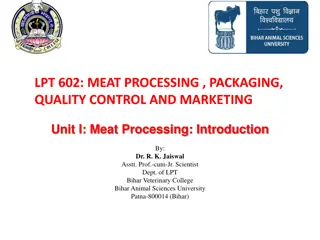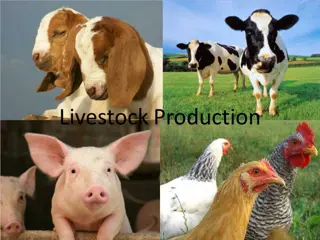Exploring the Fascinating World of Eggs: Types, Structures, and Nutritional Value
Delve into the world of eggs with a focus on different types of eggs commonly used in cooking, the intricate structures of eggs including the shell, chalazae, and albumen, and the rich nutritive value they offer, including essential vitamins, minerals, and proteins.
Download Presentation

Please find below an Image/Link to download the presentation.
The content on the website is provided AS IS for your information and personal use only. It may not be sold, licensed, or shared on other websites without obtaining consent from the author. Download presentation by click this link. If you encounter any issues during the download, it is possible that the publisher has removed the file from their server.
E N D
Presentation Transcript
Understanding Ingredients Eggs
Topics Types of Eggs Structure of Eggs Nutritive Value of Eggs Choice and Storage of Eggs Uses of Egg in Cooking / Diet Food and Nutrition Labelling of Eggs 2
Types of Eggs Eggs commonly used in our diet: Hen s egg, commonly referred as egg Duck s eggs Quail s eggs Pigeon s eggs Preserved eggs Salted eggs 4
Structure of Eggs Shell ( ) Air space ( ) Chalazae ( ) Outer membrane ( ) Thick albumen ( ) Inner membrane ( ) Membrane ( ) Thin albumen ( ) Yolk ( ) Chalaza ( ) Egg white ( ) 6
Structure of Eggs Air space Pocket of air formed at large end of egg Increases in size as egg ages Chalazae Twisted, cordlike strands of egg white Anchor yolk in center of egg Prominent chalazae indicate freshness Shell Outer covering of egg, composed largely of calcium carbonate May be white or brown depending on breed of hen 7
Structure of Eggs Shell membrane Inner and outer shell membranes that surround the albumen Air cell forms between these two membranes Provide protective barrier against bacterial penetration Thick albumen Source of riboflavin and protein Stands higher and spreads less in higher-grade eggs Thins and becomes indistinguishable from thin albumen in lower-grade eggs 8
Structure of Eggs Thin albumen Nearest to shell Spreads around thick albumen of high-quality egg Yolk Yellow portion of egg Colour varies with feed of the hen, but does not indicate nutritive content Source of egg vitamins, minerals and fat 9
Nutritive Value of Eggs A large egg (50 grams) provide: Nutrient Unit Weight Percentage Water g 38.1 75.8% Energy kcal 72 N/A Protein g 6.3 12.5% Total lipid g 4.8 9.5% Carbohydrates g 0.5 1.1% Dietary fibre g 0 0% Vitamins mg 155 0.3% Minerals mg 275 0.5% Cholesterol mg 186 0.4% Source of data: USDA National Nutrient Database for Standard Reference, Release 28 (May 2016). 11
Nutritive Value of Eggs Percentage of Nutrient (By Weight) in a Whole Egg 100% 90% 80% 70% 60% 50% 40% 30% 20% 10% 0% 12
Nutritive Value of Eggs Good source of animal protein Complete protein with a biological value of 100 (high biological value), which indicates that all of the protein is retained by the body A ovo-vegetarian may use eggs to complement their protein requirement Contains minerals Egg yolk provides calcium, iron, phosphorus, and zinc While egg white provides magnesium 13
Nutritive Value of Eggs Provides vitamins Egg yolk provides water-soluble vitamin B1, B6, B12, folate, and fat-soluble vitamin A, D, E, and K While egg white provides niacin (vitamin B3) Egg contains little fats but a fair level of cholesterol In a whole egg, lipid mainly comes from egg yolk, while egg white only contain less than 2% lipid Cholesterol only exists in yolk, it is not found in egg white Egg contains a high percentage of water In a whole egg, about 75% water comes from egg white, 25% water comes from egg yolk 14
Nutritive Value of Eggs Percentage of Constituents (By Weight) Found in Egg White and Egg Yolk 100% 98.70% 100% 90% 76.50% 80% 70% 60% 50% 40% 30% 23.50% 20% 10% 1.30% 0% 0% Total Lipid Cholesterol Water Egg White Egg Yolk 15
Choice and Storage of Eggs 16
Choice and Storage of Eggs Choosing Eggs The shell of an egg should be a bit rough, neither dirty nor damaged When an egg is put in front of a bright light, the light should pass through it and there should not be any black spots It should feel heavy as water in the egg has not dried out 17
Choice and Storage of Eggs Tests for Freshness 1. Salt water test Put 25g salt into 250ml water in a glass Fresh egg sinks, stale egg floats 18
Choice and Storage of Eggs Tests for Freshness 2. Plate test A Stale Egg A Fresh Egg Thick albumen stands higher and spreads less Thick albumen thins and becomes indistinguishable from thin albumen Stale egg spread wider than fresh egg 19
Choice and Storage of Eggs Rationale for the Tests When an egg is freshly laid, it contains carbon dioxide dissolved in the white and yolk Since egg white is 90% water , carbon dioxide is dissolved in the form of carbonic acid, therefore the water is acidic As eggs age, the carbon dioxide dissolved in the white and yolk gradually escapes through the pores in the shell Carbonic acid is essentially carbon dioxide and water As carbon dioxide leaves eggs, more liquid turns into gas The air space becomes bigger, and stale egg floats The white and yolk become more alkaline, as a result, the egg white albumen is runnier 20
Choice and Storage of Eggs Storing Eggs Do not wash the eggs before storage, bacteria may enter the shell through the pores by pressure changes in a cooling egg after washing Clean the shells with a damp cloth, if necessary Keep eggs with broad ends up in an egg rack of a refrigerator where there is limited temperature fluctuation Keep eggs away from strong-smelling food, e.g. onions Do not keep eggs past their best before date 21
Choice and Storage of Eggs Storing Eggs If egg shell is broken or cracked, components include avidin, lysozyme, and conalbumin may lose their natural ability to protect the egg against bacteria, therefore the egg must be used as soon as possible 22
Uses of Egg in Cooking / Diet 23
Uses of Egg in Cooking The function of eggs is important in food preparation. It has many uses, here are some examples: Egg as the main ingredient of a dish to provide protein, such as poached/boiled/fried/scrambled egg, omelette, egg salad Eggs are viscous and they coagulate to a solid or semisolid state; therefore, they bind ingredients such as those in meatloaf or croquettes Egg yolks contain phospholipid emulsifiers, including lecithin, emulsifiers allow two ordinarily immiscible liquids, such as in the preparation of mayonnaise Egg whites increase six to eight times in volume when beaten to a foam, as the egg white foam is heated, the protein coagulates around air cells, maintaining a stable foam structure, e.g. egg white is used in angel food cake, and meringues Egg forms a gel as it coagulates, e.g. in custards 24
Uses of Egg in Cooking The function of eggs is important in food preparation. It has many uses, here are some examples: Eggs coagulate and thicken mixtures such as custards and hollandaise sauce Egg yolk carotenoids add yellowish colour to baked products; egg glazed on bakery products improve their appearance Fat from yolk provides flavour, inhibits crystal formation in sugars, and inhibits staling Eggs provide nutritional value in cooked or baked food mixtures 25
Uses of Egg in Cooking Functional properties of eggs at a glance: Coagulation Emulsification Foaming Binding Coating Glazing Thickening 26
Uses of Egg in Cooking Eggs can be used in different ways: Breakfast e.g. poached/scrambled/hard-boiled/fried egg, Sunny Side Up, Egg Benedict Appetizer/soup e.g. smoked egg, Devil Egg, Chinese Egg Flower Soup Main course e.g. omelette, steamed egg, quiche, Scotch Egg, egg croquette, Scrambled Egg with Ham, Egg Curry Dessert e.g. meringue, ice cream, pudding, cold sweets, souffl , egg tart, egg custard Snack e.g. sandwich, Egg Puff, French toast, Tea Egg Bakery products e.g. cakes, biscuits and bread Sauce /spread e.g. custard sauce, Kaya, mayonnaise Noodles and pasta- e.g. egg noodles, fresh egg pasta 27
Food and Nutrition Labelling of Eggs 28
Food and Nutrition Labelling of Eggs Eggs that are not sold as prepackaged products in Hong Kong, is not bound to follow the nutrition labelling regulation in Hong Kong Eggs that are sold in cartoon boxes usually include information such as size, country of origin, and type In Hong Kong, egg sizes are generally differentiated as small, medium, large, and extra large, and the classification is not legally bound 29
References Provost, J., Kelly, B., Bodwin, J., & Wallert, M. (2016). The Science of Cooking. John Wiley & Sons. Vickie A. Vaclavik, Elizabeth W. Christian. Essentials of food science. New York, NY: Springer, c2008. 30






